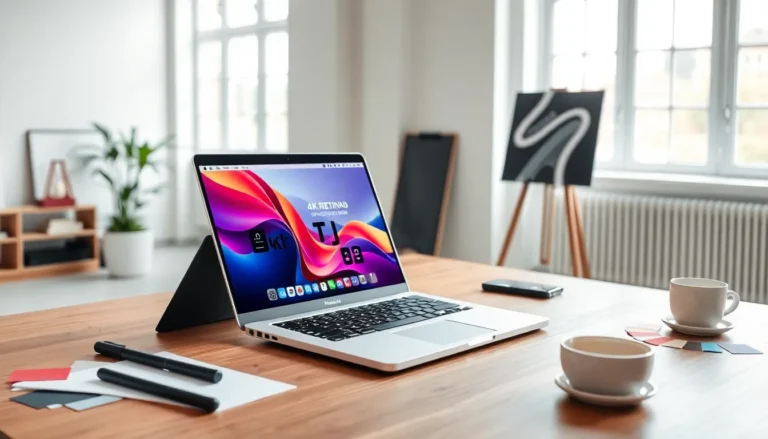In the epic showdown of laptop versus desktop, the stakes are higher than a cat on a hot tin roof. Both contenders have their loyal fans, but which one truly deserves the crown? Laptops offer the freedom to work from anywhere, whether it’s a coffee shop or a couch, while desktops boast power and performance that could make a superhero jealous.
Picture this: you’re in a café, sipping your favorite brew, and suddenly, your laptop dies. Panic sets in as you realize your entire project is trapped in electronic limbo. Meanwhile, your desktop at home stands tall, ready to tackle anything you throw at it—if only you could carry it around. This article dives into the quirks, benefits, and drawbacks of each, helping tech enthusiasts and casual users alike decide which device reigns supreme in their digital lives.
Table of Contents
ToggleOverview of Laptop vs Desktop
Laptops and desktops serve different purposes, making the choice dependent on individual needs. Portability stands out as a significant advantage of laptops, allowing users to work from cafés, libraries, or while traveling. Desktops excel in power and performance, delivering higher processing capabilities for gaming, graphic design, and intensive tasks.
Battery life plays a critical role in day-to-day usage. While laptops rely on batteries, desktops connect directly to power sources, ensuring uninterrupted use. Upgradability often favors desktops, permitting easy enhancements like RAM or graphics card updates. Laptops typically offer limited upgrade options, with many components soldered onto the motherboard.
Price offers further distinction between devices. On average, desktops provide more power for less money compared to laptops; this results in better price-to-performance ratios. Users can customize desktops to suit specific requirements, tailoring components to fit budget constraints.
Ergonomics come into play as well. Desktop setups allow for adjustable monitors, keyboards, and mice, fostering better posture during long work sessions. Laptop users may experience discomfort after extended periods due to fixed screen and keyboard placements.
Ultimately, choosing between a laptop and a desktop hinges on personal preferences and specific use cases. Those prioritizing portability may lean towards laptops for their convenience. Conversely, individuals prioritizing performance for gaming or productivity often find desktops to be the superior option. Understanding these distinctions helps individuals make informed decisions that align with their lifestyle and tasks.
Key Differences Between Laptop and Desktop

Laptops and desktops have distinct characteristics that cater to varying user needs and preferences. Understanding these differences allows users to make informed decisions.
Portability
Laptops excel in portability. Weighing between 3 to 5 pounds, they fit easily in bags, making them convenient for cafes and libraries. Users can work from almost anywhere, unlike desktops, which remain stationary. Laptops don’t require external power sources for limited durations, enhancing freedom of movement. Quick setups allow users to transition from one place to another without hassle. Those who travel frequently find laptops particularly beneficial, as their lightweight design simplifies usage in various environments.
Performance
Desktops generally outperform laptops in processing power. Higher specifications lead to better graphics and enhanced computing capabilities for demanding tasks. Users needing superior performance for gaming, video editing, or graphic design often prefer desktops. Upgrading components like RAM or graphics cards is more accessible due to the spacious design of desktop cases. In contrast, laptops have integrated systems, limiting upgrade options. Users may notice that desktops provide a longer lifespan due to the ability to swap out parts, making them a reliable choice for heavy-duty performance.
Price
Price differences between laptops and desktops are significant. Desktops usually offer a better price-to-performance ratio, delivering higher specifications for lower costs. Typical desktop setups range from $600 to $1,500, depending on components. Meanwhile, laptops often start at higher prices for comparable specifications, making budget considerations vital. Those seeking efficient performance without breaking the bank might find desktops more appealing. Consumers prioritizing portability might lean towards laptops, but they often pay a premium for this convenience.
Pros and Cons of Laptops
Laptops come with distinct advantages and disadvantages that cater to various user needs.
Advantages of Laptops
Portability stands out as a significant advantage. Users can easily transport laptops to different locations, such as cafés or libraries. Lightweight designs enhance comfortable travel. Battery operation eliminates reliance on power outlets during use, allowing flexibility for remote work. Built-in features, like webcams and microphones, facilitate video conferencing without additional hardware. Efficient energy consumption contributes to longer battery life, helping users stay productive on the go. Additionally, modern laptops often include solid-state drives, ensuring quick boot times and effective multitasking during daily tasks.
Disadvantages of Laptops
Limited performance can restrict productivity for demanding applications like gaming and graphic design. Desktop alternatives typically provide more power at a lower cost, impacting overall value. Upgrades also present challenges since many components, such as RAM or hard drives, are not easily replaceable in laptops. Shorter battery lives can hinder extended use away from power sources. Users may experience discomfort due to fixed screen angles and keyboard setups, creating strain during long sessions. Ultimately, these factors may lead users to reconsider their long-term needs when choosing between a laptop and a desktop.
Pros and Cons of Desktops
Desktops present a unique set of benefits and drawbacks, essential to consider for users evaluating their computing options.
Advantages of Desktops
Desktops provide significant processing power, making them ideal for gaming and graphic design tasks. Performance often exceeds that of laptops for similar price points, delivering superior graphics and speed. Users appreciate easy upgrades, including enhancements for RAM and storage. Ergonomics also improve, as desktops allow for adjustable screens and seating positions. Many desktop models come with larger displays, which enhance productivity with more screen real estate. Additionally, desktops usually offer better cooling systems, extending the lifespan of components by preventing overheating.
Disadvantages of Desktops
Desktops lack portability, restricting users to fixed locations like home or office setups. Moving a desktop can be cumbersome due to multiple components, including the monitor and tower. They often require a dedicated workspace, which can be a challenge in smaller living spaces. Costs may also accumulate with necessary peripherals such as monitors, keyboards, and mice, raising the initial investment. Lastly, desktops may consume more power, leading to higher energy bills over time compared to energy-efficient laptops.
Choosing between a laptop and a desktop ultimately hinges on individual needs and preferences. For those who value portability and flexibility a laptop serves as an excellent companion for work or leisure on the go. However for users demanding high performance and upgradeability a desktop remains the preferred choice.
Balancing factors like processing power battery life ergonomics and price-to-performance ratio can significantly influence the decision. Understanding these nuances empowers users to select the device that best fits their lifestyle and requirements ensuring a satisfying computing experience.





